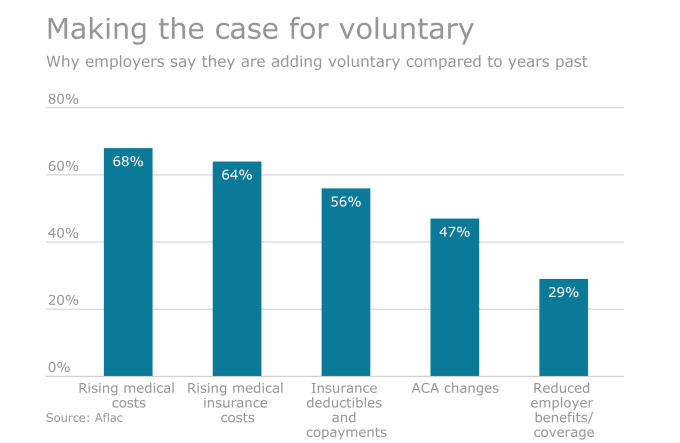
One sure-fire way to engage employees in voluntary benefits
Whether your employees are 22 or 62, they need to plan for the unexpected. A sudden injury or illness can dramatically derail their financial well-being and retirement readiness. As the responsibility for healthcare costs shifts to employees, employers are taking steps to help their employees by offering voluntary benefits, like critical illness and accident insurance.
The hitch, however, is that many employees aren’t taking advantage of these benefits.
There are many reasons for this: Employees may not have much appetite for voluntary insurance benefits after choosing medical benefits. They may not understand what’s being offered or how it is relevant to their lives. Further, if they haven’t been close to someone who has dealt with a catastrophic health issue, they may not grasp how destabilizing that is and how voluntary benefits can help at a difficult time.
So how do employers keep employees from hitting the snooze button on voluntary insurance benefits, and wake them up to how these benefits can help with their overall financial wellbeing?
One way is to understand what employees might need given their life stage, family situation or other variables. To help employees sort this out, here are few scenarios of how voluntary benefits could help employees — with fictional people based on a combination of our experiences with customers.
Leaving nothing to chance
Scott tends to be a worrier. His friends joke that he’s a 45-year-old man in a 25-year-old body. He is in the “adulting” stage of life — getting settled in a career, figuring out his personal life, and living on a salary that’s just a few steps up from entry-level. Scott worries about what might happen if he gets sick or injured and can’t meet his portion of his high-deductible plan. He’s also open about the fact that he doesn’t want to move back in with his parents. Unlike most of his friends, he’s also thinking decades ahead and is already contributing to a 401(k).
Scott wants it all — financial protection now and for the future. Based on what he’s seen happen to friends and colleagues close to his age, he chose critical care and accident insurance coverage during benefits enrollment at work. These options will help cover unexpected costs if an unexpected covered event does happen, and the cost won’t take a big chunk out of his paycheck thanks to his employer’s group rate. What’s more, the benefit is tax-free if he ever needs to use it, and can help keep him independent, and out of his parents’ house.
For employers, these kinds of benefits can help mitigate employees’ financial stressors so they can focus on wellness and getting back to work if an unexpected health issue strikes.
Weekend warriors and thrill-seeking hobbies
Catherine is a marketing manager who is married with two children. She is 44 and in the “balancing” stage of life, between “adulting” and “planning.” Her main concern when looking at voluntary insurance benefits was her husband, who likes high-thrill, risky sports. While Catherine tends to shy away from motorcycles and extreme sports, she is a bit of a weekend warrior since it’s hard to find time to exercise during the week. Her kids are also active and perpetually on the go, whether playing sports or just running around with the neighborhood kids.
Once Catherine learned about voluntary benefits, it was a no-brainer to choose accident insurance for her entire family. While she hopes that her family will only have fun — and avoid injury — doing what they all enjoy, she knows they have to be prepared for anything.
Employers can help employees choose the right benefits by encouraging them to think about how they and their families spend their leisure time, including sports, hobbies, adventure travel or any other activities.
Taking account of a family history of cancer
Meet Justin. He’s 55, married, and has a daughter. He is at the “planning” stage of life — following “adulting” and “balancing.” While Justin is healthy, his family history of cancer is a concern when he considers his future. He’s seen family, friends and colleagues struggle with the costs of a serious illness. He also is acutely aware of saving enough for retirement as he has only 10-15 more years in the workplace, during which he can save.
For Justin, his life stage, family history of cancer and concern for his family’s physical and financial well-being led to his purchasing decisions. To help mitigate financial setbacks if he should become ill, Justin purchased critical illness insurance. He also purchased critical illness and accident coverage for his wife and daughter.
From an employer point of view, emphasizing that employees should consider their family and individual medical history — and how an adverse event could impact them and their families — is a compelling way to make voluntary benefits relevant.
Making it real for employees
Many employers want to help their employees choose the right benefits for their specific needs to protect their financial well-being now and for the future. Showing how needs change with age and lifestyle sheds more light on how voluntary insurance can provide benefits for covered events that will help mitigate financial losses and reduce stress.
Digital technology is making it easier than ever to engage employees across channels with easily digestible but important information. Employers can set up “decision tools” that help employees make choices, offer videos that bring different situations to life, develop app-based calculators, and tell stories about how voluntary benefits can help them and their families during an unexpected illness or injury.
Employees have a lot on their minds. The key to making voluntary benefits real is to show employees why they matter and how to choose the right products. What many employees don’t know is that employers are working hard behind the scenes to offer benefits tailored to their workforce. This is an opportunity for employers to personalize the experience and demonstrate to employees that they truly care.
